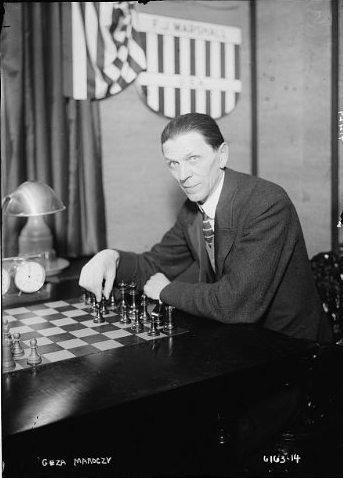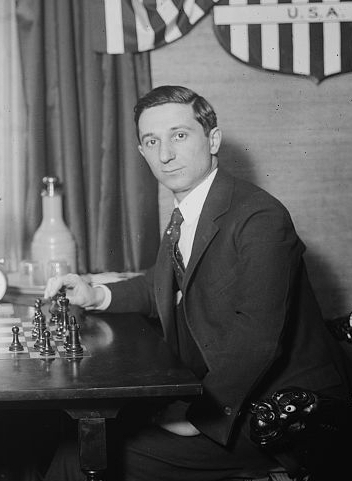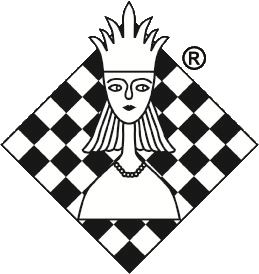New York 1924, Round 2: Alekhine starts with two wins
The new ideas in chess promoted by players such as Aron Nimzowitsch, Richard Reti or Gyula Breyer lead to an ever increasing number of opening experiments in top-level tournaments. Suddenly the best players in the world are making moves that would have been unthinkable or ridiculed in the past. A good example of this is the Alekhine Defence, in which Black plays 1.e4 Nf6!? to provoke the white e-pawn to advance and to attack the knight. With this strategy Black hopes that White overextends himself and that the pawn in the center might later become a weakness.
For a long time, this move, which allows White to quickly occupy the center with pawns, was dismissed as eccentric, but since the idea that seemingly strong pawns centers can be weak and vulnerable has gradually gained ground, top players have looked at the opening more closely.
Alekhine in particular has done a lot to make this variation popular and has tried it out more than once in serious tournament games, for example against Friedrich Sämisch and against Endre Steiner at the tournament in Budapest in 1921, probably inspired by the analyses of Moscow master Michail Kljazkin, who is a passionate advocate of Black's provocative first move, and whom Alekhine certainly knew from his time in Moscow.
Probably Alekhine has given "his" opening new followers in the second round of the tournament in New York. He was playing with Black against the Hungarian Geza Maroczy and after 1.e4 Nf6 Black managed to win a short and impressive game .

Geza Maroczy
But this was the only victory of the round. The eagerly awaited duel between former World Champion Emanuel Lasker and the reigning World Champion Capablanca ended in a draw after 30 moves. In a line of the Ruy Lopez both sides proceeded cautiously and avoided any risk.
The other games of the round were less correct but more entertaining. E.g. the encounter between Edward Lasker and Efim Bogolyubov, which once more illustrated that nothing is as difficult as winning a won game.
Edward Lasker is the only amateur in the field of professionals. He was born on December 3, 1885 in Kempen, in the province of Posen in Germany, but in 1914 he emigrated to the US after studying in Breslau and Berlin and a short interlude in London. Lasker is an engineer by profession and between 1921 and 1923 he developed an electric breast pump which has saved the lives of many babies and has made Lasker rich.

Edward Lasker in New York 1924
But although Lasker is an amateur, he should not be underestimated. E.g. the year before, in 1923, he played a match for the US Championship against Frank Marshall and only lost narrowly with 8½-9½.
Against Efim Bogoljubov Lasker showed a lot of tactical ingenuity in a bad position – and he was kind enough to explain the critical moments of the game afterwards.
An interesting game and probably more material for Edward Lasker's planned book Chess Secrets I Learned from the Masters.
After two rounds Alekhine is the sole leader with 2 out of 2. In round 3 he will meet Emanuel Lasker with White – and we will see whether Lasker still has chances against the younger generation or whether the time of the man who was World Champion for 27 years is finally over.
Results of round 2
Em. Lasker ½-½ J.R. Capablanca
Ed. Lasker ½-½ E. Bogoljubow
F. Marshall ½-½ S. Tartakower
F. Yates ½-½ D. Janowsky
G. Maroczy 0-1 A. Alekhine
Bye: Richard Reti
Standings after round 2
Games
Links
.jpeg)
























